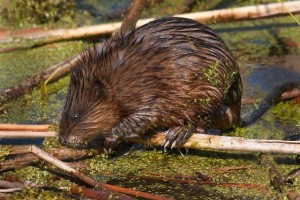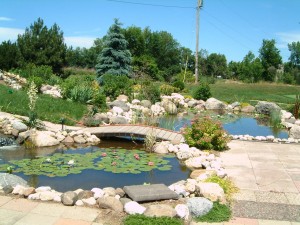Lately we have been dealing with a few damaged ponds here in Southeastern Wisconsin. Through the years, I’ve been impressed with the durability and resilience of the eco-system ponds that we install. For the most part, these ponds can withstand all sorts of abuse and come out unharmed. You can walk, jump, run or swim in your pond without the fear of wrecking anything. Your dog or dogs can use our ponds as swimming pools and drinking troughs and never do any damage. Deer can walk through and stand in these ponds and I’ve yet to see a rip in the liner from a deer hoof. I’ve driven over the pond bottom with a skid steer and an excavator. I’ve rolled huge rocks around on the rubber liner and even dropped a few huge rocks on the liner. All of these things and usually no damage. Granted, you need to be cautious and know what you’re doing to drive equipment and maneuver huge rocks on top of the rubber, but for the most part, clients ponds just don’t get damaged very easily.
The only real damage that we see is from teeth. Every spring we get a few calls from pond owners whose ponds are suddenly leaking. Most of the time this is from a hole in the rubber liner somewhere in the stream or the pond edge and it’s usually located on a vertical surface. It seems that mice like to crawl in between the rocks of our ponds and try to make themselves a little burrow for the winter. I’ve seen holes the size of oranges and tiny little holes the size of a dime. Some of the holes are clearly leading to a burrow and others simply appear to be chewed on. Either way, it is a good thing to look for if your pond has a sudden leak as soon as you fire it up in spring.
Sure, this mouse hole business is definitely damage, but it is not really the damage that I was refering to when I started this post. The damage that I was refering to is similar but on a much larger scale. Instead of orange or dime size holes, I’ve seen long holes large enough to pass a party sub sandwich through, sideways! I’ve seen multiple holes the size of a grapefruit in one pond. I’ve seen ponds with an entire wheelbarrow’s worth of dirt in them. Damage to this extent, here in Ozaukee county Wisconsin, I’ve only seen done at the hands (or should I say teeth) of the pond spoiling MUSKRAT!
It seems that the Muskrat likes to swim in ponds and eat the various aquatic plants that we pond owners like to keep in our ponds. Once they find a pond full of tasty food then they start to think about moving in to stay. This is when the real trouble starts. Like the mice, they find a gap between the rocks and they also burrow into the rubber to make a nest. The difference here is that the mice usually do it in winter and usually do it in the stream or in an edge above the water line. The Muskrat does it any time of the year and does it well below the water line. They want to create a burrow that is only accessible from under the water to discourage their predators from joining them I would imagine. So, they dig and dig and dig. I’ve seen holes that start one or two feet below the water line with burrows that go for ten feet into the pond bank. At my house we had one make a burrow that twisted and turned and ended up under my stream. They want to access it from the water and then create a burrow above the water line to stay dry. I’ve seen where they, for whatever reason, burrow just behind the rocks in the pond tearing up the rubber all along their path. This is where the party sub effect comes in. I’ve seen long holes about six inches wide that stretch for six to eight feet! Talk about a lot of patching work. Of course, when tunneling, the spoils must go somewhere. That somewhere is in your pond. These pesky creatures push all of the excavated soil into your pond. So now, not only do you have a pond that is losing water at an alarming rate, but you also have a big pile of mud in your pond.
What to do, what to do? Well, you definitely want to get these pests out of your pond as soon as possible. If you ever notice chewed up plant material floating in your pond, you probably have a Muskrat. At this point you had better act quick. I’ve heard of people shooting them or trapping them. I suppose the most humane method would be the live trap, but the Muskrat is a prolific breeder and one female can have up to four litters a season of up to four to eight young each, so I wouldn’t worry about the population. There is a legal muskrat trapping season in the fall here in Wisconsin.
The patching and clean up from a muskrat can go on for a day or two. Obviously you need to pump down the water to a level below the holes, or maybe the pond is already at this level due to the gaping hole in the liner. Find the hole by looking for the telltale pile of mud in the pond or by looking for the chucks of chewed up rubber scattered about the pond floor. Look in between rocks anywhere that a Muskrat head would fit. Most of the time you will need to remove all of the rock from the area where you found the first hole. Moving all adjacent rock will oftentimes reveal more holes. Once you feel that you have located all of the holes, you can patch them and try to remove as much of the mud as possible from the pond. If the holes are too large to patch, you may need to seam in an entirely new piece of rubber. When all of this is done, put the rocks back in place and fill the pond to test your patches. Keep your fingers crossed, there might be multiple holes in multiple areas. If you’re not careful, you may need to drain the pond again to find the missing hole.
Luckily, I’ve only seen muskrat damage in five lined ponds since I’ve started installing them, so this doesn’t happen too often, but when it does it is a real mess. I have seen natural bottom ponds drained by muskrats also, it is very similar, except they just burrow through the side of the pond. Sometimes they do this simply to create their burrow, other times they want an underground passage from the pond to an adjacent wetland area. This can be a very hard problem to fix and I’ve heard of people trenching around their ponds with deep trenching machines so that they can fill the trench with heavy clay or concrete hoping to stop the burrowing.
I am currently working on a pond that is rubber lined and was damaged by a Muskrat last fall. We went in to try to patch it in late fall, but we didn’t find all of the holes, so the pond still leaked. The homeowner took all of his fish into the basement for the winter and kept them in huge tanks. We are now in the process of removing all of the rock from the pond and replacing the liner. Once the new liner is in, we will line the pond with stainless steel screening to prevent any more burrowing. I have never tried this approach before, but the homeowner found the screening and wants to give it a try. I guess a winter with a basement full of fish will inspire one to go to great lengths to avoid this in the future. The pond is about 18′ x 25′ x 3′ deep and the stainless steel screening cost about $3000. Wow, what an expensive repair job. I feel really bad about the disruption of the yard, the pond eco-system and the homeowners pocket book, but hopefully he’ll never have this problem again.
We did have one homeowner request protection a few years ago and we installed a galvanized hardware cloth on top of the rubber on only the first shelf level. The mesh was about 1/4″ squares and was quite rigid. It wasn’t much fun to work with and we really needed to protect the rubber from it’s sharp protruding wires. We haven’t been back to repair any holes, but I don’t know if that is because of the mesh or because there just haven’t been any more Muskrats in the pond.
I sincerely hope that you never need to deal with this type of pond damage, but if you do I wish you the best of luck with your repairs.
Doug






